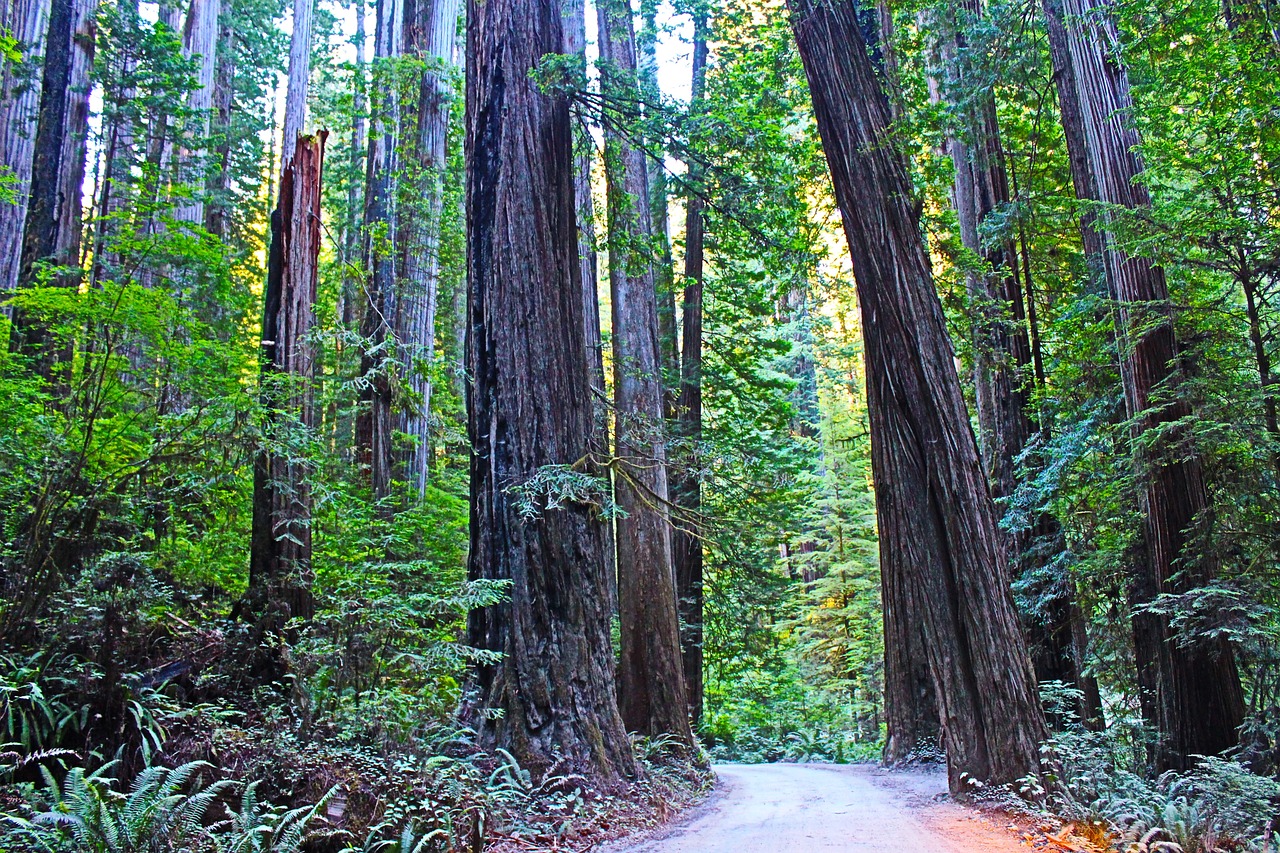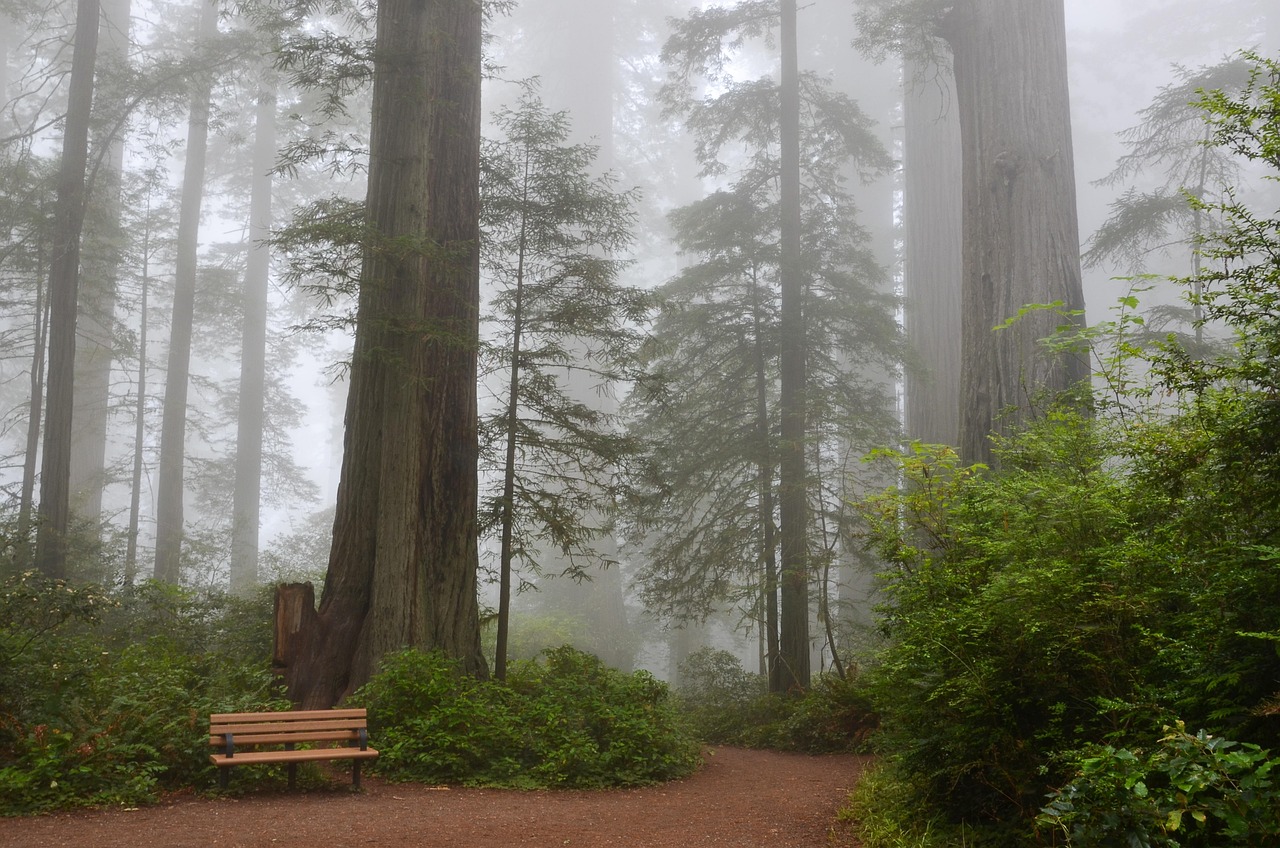Redwood trees, specifically the coast redwoods (Sequoia sempervirens), can grow at an impressive rate of 2 to 3 feet per year under ideal conditions. These ancient giants can reach heights of over 350 feet and live for thousands of years, making them one of the fastest-growing and longest-living tree species on Earth.
Understanding Redwood Trees
Redwood trees are known for their towering heights and remarkable longevity. Found primarily in the coastal regions of northern California, they thrive in a unique climate that combines wet winters and dry summers. This environment is essential for their growth, as redwoods require ample moisture to reach their full potential.

The coast redwood is not only the tallest tree species in the world but also one of the most ancient. Some individuals are believed to be over 2,000 years old. Their ability to grow rapidly in height is linked to several biological and environmental factors that make them stand out among other tree species.
Growth Conditions
The growth rate of redwood trees is influenced by various factors, including soil quality, moisture availability, sunlight exposure, and temperature. Here are some critical elements that contribute to their rapid growth:
- Soil Quality: Redwood trees prefer well-drained soils rich in nutrients. They thrive in sandy loam or clay loam that retains moisture while allowing excess water to drain away.
- Moisture: These trees benefit from a high level of rainfall. Coastal fog also plays a significant role by providing additional moisture during dry periods.
- Sunlight: Redwoods require full sunlight for optimal growth. They typically grow best in open areas where they can receive direct sunlight throughout the day.
- Temperature: Moderate temperatures are ideal. Extreme heat or cold can hinder their growth. Coastal redwoods thrive in temperatures ranging from 40°F to 90°F.
Growth Rate Insights
The growth rate of redwood trees can vary significantly based on their age and environmental conditions. Young redwoods tend to grow faster than older trees. In the first few decades of life, they can achieve remarkable heights, sometimes exceeding 50 feet within 20 years. However, as they mature, their growth rate slows down considerably.

Research shows that redwoods have a unique ability to adapt their growth based on competition and available resources. When surrounded by other trees, they may grow taller and straighter to reach sunlight, a phenomenon known as “phototropism.” This competitive growth behavior is essential in dense forest environments where light is limited.
Comparative Growth Rates
To better understand the growth rates of redwoods compared to other tree species, the following table summarizes the average annual growth rates of selected trees:
| Tree Species | Average Annual Growth Rate (Feet) |
|---|---|
| Coast Redwood | 2 – 3 |
| Sugar Maple | 1 – 2 |
| White Oak | 1 – 2 |
| Ponderosa Pine | 1 – 3 |
This table highlights the impressive growth rate of coast redwoods compared to other popular tree species. Their ability to grow rapidly makes them a vital part of their ecosystems and a fascinating subject for study in forestry and ecological research.

The growth patterns of redwoods also provide insight into forest dynamics. As these trees age, their massive trunks and extensive root systems support other forms of life, from plants to animals. The towering canopies create unique habitats that contribute to biodiversity in ancient forests.
Overall, understanding the growth rate and conditions favorable for redwood trees is crucial for conservation efforts. Protecting these giants ensures that future generations can appreciate their beauty and ecological significance.
Factors Influencing Redwood Growth Rates
The growth rate of redwood trees is not solely determined by their genetic makeup. Several environmental and biological factors play critical roles in shaping how quickly these majestic giants can grow. Understanding these factors is essential for fostering healthy redwood ecosystems.

Soil Composition
Soil plays a vital role in the growth of redwood trees. The composition and quality of the soil directly influence nutrient availability and water retention. Key aspects of soil that affect redwood growth include:
- Nutrient Levels: Redwoods thrive in soils rich in nitrogen, phosphorus, and potassium. These nutrients are crucial for photosynthesis and overall tree health.
- pH Levels: A slightly acidic to neutral pH (around 6.0 to 7.0) is ideal for redwoods, facilitating nutrient absorption.
- Drainage: Well-drained soils are essential. Redwoods are sensitive to waterlogged conditions, which can lead to root rot.
Climate Conditions
Climate is another significant factor affecting the growth rate of redwood trees. The ideal climate for coast redwoods features specific characteristics:
- Moderate Temperatures: Coast redwoods prefer temperatures between 40°F and 90°F. Extreme temperatures can stress the trees and impede growth.
- High Humidity: Coastal fog and high humidity levels help maintain moisture in the air and soil, allowing redwoods to absorb water efficiently.
- Rainfall: An average annual rainfall of 30 to 100 inches is optimal for redwoods, providing sufficient moisture for healthy growth.
The Role of Competition
Redwood trees often grow in dense forests where competition for light, water, and nutrients is fierce. This competition can either hinder or promote growth, depending on various factors.
Light Competition
As redwoods grow taller, they compete with neighboring trees for sunlight. The ability to reach upward is crucial for their survival. Some key points about light competition include:
- Phototropism: Redwoods exhibit phototropism, where they grow towards available light. This adaptation allows them to maximize photosynthesis.
- Canopy Dynamics: The forest canopy created by tall redwoods influences the growth of understory plants and younger trees. These dynamics can impact the overall health of the forest.
Nutrient Competition
Nutrient availability can be limited in dense forests, leading to competition among trees. Some important aspects include:
- Root Systems: Redwoods develop extensive root systems that can spread out wide and deep, allowing them to access nutrients and water that other plants might not reach.
- Mycorrhizal Relationships: Many redwoods form symbiotic relationships with mycorrhizal fungi, which help improve nutrient absorption. These relationships enhance overall growth rates by increasing the tree’s access to essential nutrients.
Impact of Forest Management
The management practices applied to redwood forests can significantly influence their growth rates. Sustainable forestry practices aim to balance ecological health with economic benefits.
Sustainable Practices
Implementing sustainable forest management practices can help ensure healthy growth rates for redwoods. Some effective strategies include:
- Selective Logging: This method involves removing only specific trees while preserving the overall forest structure, ensuring that remaining trees have adequate resources.
- Controlled Burns: Fire can be beneficial for redwood ecosystems by reducing underbrush and recycling nutrients back into the soil.
- Reforestation Efforts: Planting young redwoods in areas where they have been harvested helps maintain population levels and supports ecosystem stability.
Research and Conservation Efforts
Numerous organizations and researchers are dedicated to studying redwood trees and their ecosystems. Their efforts aim to promote conservation and ensure these ancient giants continue to thrive.
Ongoing Studies
Research focused on redwood growth rates examines various aspects of their biology and ecology. Some significant areas of study include:
- Climate Change Effects: Investigating how changing climate conditions may impact growth rates and overall health.
- Pest Management: Understanding pest threats and developing strategies to mitigate their impact on redwood populations.
- Biodiversity Surveys: Evaluating the diversity of plant and animal species associated with redwood ecosystems to promote habitat protection.
Through these research initiatives, scientists aim to enhance our understanding of redwood growth patterns while guiding conservation strategies that will protect these remarkable trees for future generations.
Redwood Forest Ecosystems
Redwood trees are not just remarkable for their size and growth rate; they also play a crucial role in maintaining the health and diversity of the ecosystems in which they live. These ancient forests are complex systems that support a wide array of flora and fauna.
Flora Associated with Redwood Forests
The unique microclimate created by the towering redwoods allows for a diverse range of plant species to thrive in their understory. Some of the most common plants found in redwood forests include:
- Ferns: Various species of ferns, such as the sword fern and deer fern, thrive in the moist, shaded environment beneath the redwoods.
- Mosses: Mosses grow abundantly on the forest floor and on the trunks of mature redwoods, contributing to the forest’s biodiversity.
- Wildflowers: Seasonal wildflowers, like trilliums and oxalis, bloom in spring, adding splashes of color to the forest floor.
- Understory Trees: Species such as tanoak and Douglas fir can also be found among the redwoods, contributing to the overall forest structure.
Fauna of Redwood Forests
The rich biodiversity of redwood forests extends beyond plants to include numerous animal species. These forests serve as habitats for a variety of wildlife:
- Birds: Numerous bird species, including spotted owls, woodpeckers, and jays, rely on the redwood canopy for nesting and feeding.
- Mammals: Animals such as black bears, deer, and bobcats can be found within these forests, utilizing both the trees and the abundant understory vegetation for food and shelter.
- Insects: A diverse array of insects plays critical roles in pollination and decomposition processes within the ecosystem.
Ecological Functions of Redwood Trees
Redwood trees contribute significantly to their ecosystems through various ecological functions. Their presence provides numerous environmental benefits, including:
Carbon Sequestration
One of the most crucial ecological roles of redwood trees is their ability to sequester carbon dioxide from the atmosphere. Their large biomass allows them to store vast amounts of carbon, making them essential in combating climate change. Key points include:
- Carbon Storage Capacity: Mature redwoods can store over 1,000 tons of carbon per hectare, making them one of the most effective carbon sinks among terrestrial ecosystems.
- Climate Regulation: By absorbing carbon dioxide, redwoods help mitigate greenhouse gas emissions and contribute to climate stability.
Soil Stabilization
The extensive root systems of redwood trees play a vital role in stabilizing soil. This process is essential for preventing erosion, especially in hilly or mountainous areas. Important aspects include:
- Root Structure: The deep and wide-spreading roots anchor the trees securely, reducing soil movement during heavy rains or storms.
- Nutrient Cycling: Fallen leaves and branches decompose and enrich the soil, enhancing its fertility for surrounding plants.
The Impact of Climate Change on Redwood Growth
Climate change poses significant threats to redwood forests. Changes in temperature, precipitation patterns, and extreme weather events can adversely impact growth rates and forest health.
Effects of Rising Temperatures
As global temperatures rise, redwoods may face several challenges:
- Drought Stress: Increased temperatures can lead to prolonged droughts, stressing redwood trees and slowing their growth rates.
- Pest Infestations: Warmer conditions may enable pests and diseases that affect redwoods to thrive. This can weaken trees and reduce their resilience.
Changes in Precipitation Patterns
The alteration of precipitation patterns can also affect redwood growth:
- Reduced Fog Availability: Coastal fog is crucial for maintaining moisture levels in redwood forests. A decrease in fog can lead to water stress.
- Altered Water Supply: Changes in rainfall distribution may impact groundwater recharge rates and soil moisture levels.
Conservation Strategies for Redwood Forests
To ensure the survival of redwood forests in the face of climate change and other threats, several conservation strategies are being implemented. These initiatives aim to protect both the trees and their ecosystems.
Protected Areas
The establishment of national and state parks has been critical for preserving redwood forests. Notable protected areas include:
- Redwood National Park: This park encompasses over 138,000 acres of old-growth redwood forest, providing a refuge for these ancient giants.
- Jedediah Smith Redwoods State Park: Known for its stunning groves of old-growth redwoods, this park plays a vital role in conservation efforts.
Sustainable Forestry Practices
Sustainable forestry practices focus on balancing ecological health with economic needs. Effective strategies include:
- Timber Harvesting Regulations: Implementing strict guidelines for logging activities helps minimize ecological impact while allowing for responsible timber production.
- Community Engagement: Involving local communities in conservation efforts fosters stewardship and promotes awareness about the importance of protecting redwood ecosystems.
Through these combined efforts in research, conservation, and sustainable practices, we can work toward ensuring that redwood trees continue to thrive in their ancient forests for generations to come.
Challenges Facing Redwood Forests
Despite the conservation efforts in place, redwood forests face numerous challenges that threaten their survival. Understanding these challenges is crucial for effective management and protection strategies.
Invasive Species
Invasive species pose a significant threat to the delicate balance of redwood ecosystems. Non-native plants and animals can outcompete native species for resources, leading to reduced biodiversity. Some notable invasive species affecting redwood forests include:
- English Ivy: This vine can climb trees and smother native vegetation, limiting growth and light availability for understory plants.
- Scotch Broom: This shrub spreads rapidly and can alter soil composition, making it difficult for native plants to thrive.
- Forest Pests: Insects such as bark beetles can weaken redwood trees, making them more susceptible to disease and environmental stress.
Climate Change Acceleration
The effects of climate change are becoming increasingly pronounced, impacting weather patterns and natural processes essential for redwood health. Some key aspects include:
- Increased Wildfire Risk: Higher temperatures and prolonged drought conditions elevate the risk of wildfires, which can devastate large areas of redwood forests.
- Altered Water Availability: Changes in rainfall patterns may lead to water shortages that affect redwood growth and survival, especially during critical growing seasons.
- Shifted Ecosystem Dynamics: The changing climate may lead to shifts in species distributions, potentially disrupting the symbiotic relationships within the ecosystem.
The Role of Technology in Conservation
Advancements in technology are playing a pivotal role in the conservation and management of redwood forests. Innovative tools and methods are being employed to enhance research and conservation efforts.
Remote Sensing
Remote sensing technology allows researchers to monitor forest health and growth patterns over large areas. Key benefits include:
- Mapping Tree Canopies: Satellite imagery can provide detailed maps of tree canopy cover, helping to assess forest density and overall health.
- Monitoring Changes Over Time: Longitudinal studies using remote sensing techniques help track changes in forest dynamics and inform management strategies.
Drones in Conservation
Drones are becoming increasingly popular in conservation efforts. They offer several advantages, including:
- Aerial Surveys: Drones can conduct detailed aerial surveys of redwood forests, allowing researchers to collect data on tree health, growth rates, and biodiversity.
- Difficult Access Areas: Drones can easily reach remote or difficult terrains, providing crucial insights into areas that may be hard to study on foot.
Community Involvement in Conservation
Community involvement is essential for the successful conservation of redwood forests. Engaging local communities fosters a sense of stewardship and responsibility for these ancient ecosystems.
Education Programs
Educational outreach programs can raise awareness about the importance of redwood forests. Benefits include:
- School Programs: Integrating forest education into school curricula helps instill a sense of environmental responsibility in younger generations.
- Volunteer Opportunities: Organizing community clean-up events and restoration projects encourages active participation in conservation efforts.
Partnerships with Local Organizations
Collaboration between government agencies, non-profits, and local communities enhances conservation strategies. Successful partnerships often lead to more effective management practices, including:
- Resource Sharing: Collaborating organizations can share resources, knowledge, and funding to improve conservation outcomes.
- Joint Initiatives: Working together on initiatives like habitat restoration or educational campaigns amplifies the impact of conservation efforts.
Conclusion
The growth rates of redwood trees reflect their remarkable adaptability and resilience. These ancient giants not only capture our imagination but also play an essential role in their ecosystems. Through understanding the factors influencing their growth, the challenges they face, and the importance of conservation efforts, we can work together to protect these majestic trees for future generations.
Sustainable forestry practices, community involvement, and technological advancements are key components in ensuring the survival of redwood forests. By fostering respect and appreciation for these magnificent trees, we can secure their legacy as one of nature’s greatest treasures. The future of our redwood forests depends on our collective actions today—ensuring that these giants continue to inspire awe and wonder for many years to come.
As stewards of the environment, it is our responsibility to advocate for the protection of redwood ecosystems. By supporting conservation initiatives and engaging with local communities, we can help safeguard these ancient forests against the challenges they face in an ever-changing world.
